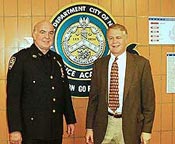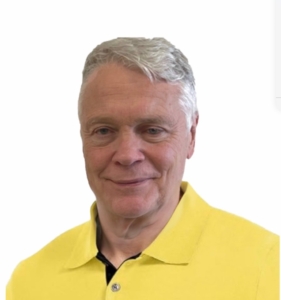The Voice Of Authority – Part 1
Giving New York’s Finest An Edge: Verbal Judo
By Christopher Caile
Editor’s Note: This is the first in a three part series on NYPD’s Tactical Communications Training. Part one discussed inception of the program and its goals. Part 2 focuses on training, while Part 3 provides an overview of the programs concepts and principles.

Detective James Shanahan, Senior Instructor, and Sergeant Amado Maldonando, Instructor/Supervisor, of the New York City Police Academy. They teach Tactical Communication to all new recruits, officers and those entering command positions, or undergoing advancement.
The next time you talk to a New York City police officer, you may be surprised. He may sound almost friendly. And if he asks you to do something, it may sound more like a request than an order.
It is training. The New York Police Department is giving its officers and recruits innovative training in a martial arts based conflict resolution course called Tactical Communications.
Since 1995 Tactical Communications, formerly known as Verbal Judo, has been taught to all new and current officers – over 44,000 to date. And the nearly 1,000 recruits now enrolled in the police academy will have had this training before they graduate.
The conflict resolution training does not stand alone, however. It is an integral part of a compliance continuum that starts with word and graduates to physical means when necessary. Given the right communications strategy, however, the verbal component can be used in the great majority of situations.
Although this article focuses on the NYPD, it is also about us: The effect of our attitude, what we say, how we say it, and the body language presented. They can deflate anger and emotion or inflate them. They can reduce agitation or potential aggression or feed it. They can help find common ground or create misunderstanding. They can sometimes function as self-defense as in a street situation, but elsewhere, as in the home or office and among the family work to help relations and help you achieve your goals.
A vast majority of the time words are effective, but when words fail, or when there is a physical attack or violence, especially if there is a weapon involved, a physical response is called for. But, verbal communications can be used to diffuse situations before they become physical. This can reduce the need for physical means of persuasion during an officer’s daily activities.
One immediate benefit is to the police officer himself. Physical danger inherent in police work is reduced. So is stress. At the same time the police officer is trained to project increased professionalism which aids his or her ability to project authority.
The system can be used in connection with traffic stops, arrests, a hostage situation, dealing with altercations, controlling people – anywhere a police officer needs to gain compliance as well as during routine interactions with the public such as dealing with people who are injured, lost or in need of assistance. It even is useful when answering questions. Citizens benefit too.
“One of the goals of law enforcement is to gain compliance,” says Detective James Shanahan, a senior instructor at the New York City Police Academy and hostage negotiator. “Experience shows us that the safest, most efficient and effective form of compliance is voluntary compliance. In plain language this is the ability to get people to do what you need them to do while allowing them to believe it was their idea.” Shanahan, a martial artist who has been in the NYPD for over twenty-six years, says, “I have had to learn to verbally blend with people, rather than collide with them. I have worked with cops who were so skilled at dealing with people, I am certain they could talk a rabid dog off a meat truck.”
This is why the course is also sometimes referred to as Verbal Judo.
The course work was initially based on a body of research pioneered by Dr. George Thompson. Thompson, a professor of literature and Judo black belt, gave up his position to become a police officer so he could study their skills and methods. He published his research in a book called “Verbal Judo: The Gentle Art of Persuasion”.
Thompson’s original work is an amalgamation of western style persuasive speaking techniques and industrial psychology blended with insights and philosophy from eastern martial arts. Included are segments in ego deflation and raising self esteem.
Despite the success of Tactical Communications training, there has been little press about the program. This is unfortunate because it might help offset some of the negative headlines generated by several unfortunate incidents involving the use of physical force such as the Amadou Diallo incident in 1999.
The need for refined training on the use of less than lethal and even the less than physical force was recognized in the mid-1990s. The negative press and uproar over the Rodney King beating and arrest by the Los Angles police in 1995 convinced law enforcement agencies across the country that new and less forceful ways of dealing with people were needed. In New York City an outgrowth of this concern was initially having Dr. Thompson teach Verbal Judo to the NYPD for a period of time.
Subsequently this initial program evolved. Having developed an expert team of NYPD trainers the program became known as the CPR (Courtesy, Professionalism and Respect) Program. Years later, this program was again modified, updated and refined and became known as Tactical Communication. This version of this course work remains a core philosophical underpinning of the academy curriculum.
In decades past, training was different. There was a large cadre of experienced officers who would take new officers under their wing. Sometimes this worked well. When it did, new officers would then be trained by senior street-experienced officers. They were shown proven and effective ways of communicating and dealing with civilians in the course of their duty. Many of these older, experienced cops were tremendous communicators. As natural intuitive communicators they know how to avoid conflict with words and used persuasion to get what they needed. But what was lacking was a systemic comprehensive form of training.
Other officers were known to resort to less effective persuasion by natural language and force. Training was not uniform, and thus enforcement wasn’t either.
Over the last decade the composition of the New York City police force has changed. There has been a huge influx of new officers. Currently nearly 30 percent of the force has been on the job for four years or less. This represents a huge turnover and influx of new recruits. The old cadre of experienced officers has been depleted largely due to retirement, for which they receive pay and benefits after 20 years of service. The turnover increases the need for institutionalized training.
Teaching a police force the size of New York City’s is not an easy task. It is huge, the size of a small army distributed over the five boroughs. Police officers also represent a rich mix of races, cultural backgrounds and levels of education. Training also involves trying to retrain a great number of officers who have been on duty for years and developed their own methods and procedures of conduct.
Despite these obstacles the ongoing New York Police Academy’s Tactical Communication program has made great strides in teaching its officers useful communications tools, strategies and methods of conduct. If used properly they can simplify a large part of the job of officers on the street, but also increase citizen compliance while reducing complaints.
Author’s Note: This author was invited by the New York Police Department’s Deputy Commissioner of Training, Wilbur L. Chapman, to attend several seminars at the New York City Police Academy and at John Jay College in Manhattan to witness seminars in Tactical Communication training first hand. I attended three training sessions taught by Detective James Shanahan, a senior instructor of NYPD academy who is also a member of the adjunct faculty at John Jay.

Detective James Shanahan, Senior Instructor, at the New York Police Academy with Christopher Caile, Editor of FightingArts.com at the entrance of the New York Police Academy.

About the Author Christopher Caile

Screenshot
Christopher Caile is the Founder and Editor-In-Chief of FightingArts.com. He has been a student of the martial arts for over 65 years.
He first started in judo while in college. Then he added karate as a student of Phil Koeppel in 1959 studying Kempo and Wado-Ryu karate. He later added Shotokan Karate where he was promoted to brown belt and taught beginner classes. In 1960 while living in Finland, Caile introduced karate to that country and placed fourth in that nation’s first national judo tournament.
Wanting to further his karate studies, Caile then hitch hiked from Finland to Japan traveling through Scandinavia, Europe, North Africa, the Middle East and South and Southeast Asia — living on 25 cents a day and often sleeping outside.
Arriving in Japan (1962), Caile was introduced to Mas Oyama and his fledgling full contact Kyokushinkai Karate by Donn Draeger, the famous martial artist and historian. Donn also housed him with several other senior international judo practitioners. Donn became Caile’s martial arts mentor, coaching him in judo and introducing him to Shinto Muso-ryu under Takaji Shimizu.
Caile studied at Oyama’s honbu dojo and also at Kenji Kurosaki’s second Tokyo Kyokushinkai dojo. In his first day in class Oyama asked Caile to teach English to his chief instructor, Tadashi Nakamura. They have been friends ever since. Caile also participated in Oyama’s masterwork book, “This Is Karate.”
Caile left Japan with his black belt and designation as Branch Chief, the first in the US to have had extensive training in Japan directly under Oyama Sensei. As such, Oyama Sensei asked him to be his representative on visits to his US dojos to report on their status.
A little over a year later, Nakamura, Kusosaki and Akio Fujihira won an epic David vs. Goliath challenge match against Thailand’s professional Muay Thai Boxers in Bangkok, Thailand, thrusting Kyolushinkai and Nakamura into national prominence.
Back in the US Caile taught Kyokushinkai karate in Peoria, Il while in college and later in Washington, DC. while in graduate school. Durimg this time Shihan Nakamura had moved to New York City to head Kyokushinkai’s North American Operation.
In 1976 when Kaicho Tadashi Nakamura formed the World Seido Karate organization, Caile followed. Living then in Buffalo, NY, Caile taught Seido karate and self-defense at the State University of New York at Buffalo (SUNY Buffalo) for over 15 years where he also frequently lectured on martial arts and Zen in courses on Japanese culture.
Caile moved to New York City in 1999 to marry Jackie Veit. He is now an 8th degree black belt, Hanshi, training in Seido Karate’s Westchester, NY Johshin Honzan (Spiritual Center) dojo. In Seido Caile is known for his teaching of and seminars on kata applications. He also produced a 14 segment video series on Pinan kata Bunkai currently available to Seido members.
Caile is also a long-time student and Shihan in Aikido. He studied in Buffalo, under Mike Hawley Shihan, and then under Wadokai Aikido’s founder, the late Roy Suenaka (uchi deshi under Morihei Ueshiba, founder of Aikido and was Shihan under Tohei Sensei). In karate, Suenaka (8thdan) was also an in-house student of the Okinawan karate master Hohan Soken.
Having moved to New York City, Caile in 2000 founded this martial arts educational website, FightingArts.com. Twenty-five years later, in 2025, it underwent a major update and revision.
For FightingArts.com and other publications Caile wrote hundreds of articles on karate, martial arts, Japanese art, Chinese Medicine and edited a book on Zen. He also developed relationships with a cross section of leading martial arts teachers. Over the last four decades he has conducted extensive private research into karate and martial arts including private translations of the once secret Okinawan hand copied and passed on Kung Fu book, the Bubishi, as well as an early karate book by the karate master Kenwa Mabuni. He periodically returns to Japan and Okinawa to continue his studies and participate Seido karate events. In Tokyo he practiced (with Roy Suenaka Sensei) in a variety of aikido organizations with their founders – including private interviews and practices at the Aiki-kai Aikido Honbu dojo with the son and grandson of aikido’s founder, Doshu (headmaster) Kisshomaru (an old uchi-deshi friend) and his son, Moriteru Ueshiba and in Iwama with Morihiro Saito. On Okinawa he studied Goju Ryu karate under Eiichi Miyazato, 10th dan founder of Naha’s Jundokan, and also with Yoshitaka Taira (who later formed his own organization, who specialized in kata Bunkai. While there Caile also trained with Hohan Soken’s senior student, Master Fusei Kise, 10 dan as well as with the grandson of the legendary karate master Anko Itosu.
Caile’s other martial arts experience includes: Diato-ryu Aikijujitsu and Kenjitsu, kobudo, boxing, Muay Thai, MMA, Kali (empty hand, knife and bolo), study of old Okinawan Shoran-ryu & Tomari body mechanics, study of old Okinawan kata under Richard Kim, study of close quarter defense and combat, including knife and gun defenses, Kyusho Jitsu and several Chinese fighting arts including 8 Star Praying Mantis, Pak Mei (White Eyebrow), and a private family system of Kung Fu.
Caile is also a student of Zen as well as a long-term student of one branch of Traditional Chinese Medicine, Chi Kung (Qigong). As one of two senior disciples of Chi Kung master Dr. Shen (M.D., Ph.D.) Caile was certified to teach and practice. This led to Caile’s founding of the The Chi Kung Healing Institute on Grand Island, NY. In Western NY, he also frequently held Chi Kung seminars, including at SUNY Buffalo and at the famous Chautauqua Institution in Chautauqua, NY. His articles on Chi Kung also appeared in the Holistic Health Journal and in several books on alternative medicine.
Caile holds a BA in International Studies from Bradley University and MA in International Relations with a specialty in South and Southeast Asia from American University in Washington, D.C. While in Buffalo, NY he also studied digital and analog electronics.
In his professional life Caile also worked in public relations and as a newspaper reporter and photographer. Earlier he worked in the field of telecommunications including Managing a Buffalo, NY sales and service branch for ITT. He then founded his own private telephone company. This was followed by creation of an electrical engineering company that designed and patented his concept for a new type of low-cost small business telephone system (which was eventually sold to Bell South). The company also did contract work for Kodak and the US space program. Simultaneously Caile designed and manufactured a unique break-apart portable pontoon boat.
Most recently Caile co-founded an internet software company. Its products include software suites with AI capability for control and management of streaming media, such as video and music, an all-in-one book publishing software product for hardcover, eBook and audio book creation and security software for buildings and government use.
For more details about Christopher Caile’s martial arts, work experience and life profile, see the About section in the footer of this site.
Search for more articles by this author:






